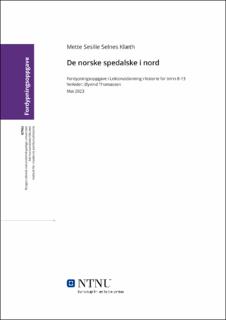| dc.contributor.advisor | Thomassen, Øyvind | |
| dc.contributor.author | Klæth, Mette Sesilie Selnes | |
| dc.date.accessioned | 2023-06-24T17:19:25Z | |
| dc.date.available | 2023-06-24T17:19:25Z | |
| dc.date.issued | 2023 | |
| dc.identifier | no.ntnu:inspera:144861250:68317052 | |
| dc.identifier.uri | https://hdl.handle.net/11250/3073047 | |
| dc.description.abstract | Spedalskhet sies å ha vært i Norge siden vikingtiden, men ble gradvis en større og mer reell trussel mot den norske befolkningen. Ved midten av 1800-tallet hadde smitten nådd nye høyder i Norge, da spesielt på Vestlandet og i Nord-Norge, og medførte en så stor trussel mot allmenbefolkningen at Stortinget så det nødvendig å opprette nye pleieanstalter som spesifikt skulle ta seg av de som var smittet av spedalskhet samt skjerme den øvrige befolkningen fra smittefaren.
Denne fordypningsoppgaven i historie omhandler spørsmålet om hvorfor det på midten av 1800-tallet ble nødvendig å opprette totalt fire nye pleieinstitusjoner for mennesker som var smittet av spedalskhet, og i tillegg hvorfor Trondheim ble valgt som en av lokasjonene for disse. Tittelens betydning omhandler at Reitgjerdet var den pleiestiftelsen som mottok spedalske fra de nordlige delene av landet – dermed De norske spedalske i nord.
Oppgaven konkluderer med at den økende andelen spedalske i landet kombinert med et ønske om å «finne en løsning på spedalskheten» gjorde at disse pleiestiftelsene ble opprettet, og at Trondheim ble valgt som lokasjon da byens historie og lokasjon gjorde den til et beleilig valg. | |
| dc.description.abstract | Leprosy is said to have existed in Norway since the Viking Age, but gradually became a bigger and more substantial threat towards the Norwegian population. By the mid-19th century, the disease presented such a threat towards the non-infected population that the Norwegian National Assembly at the time regarded it necessary to establish four new institutions that specifically handled those who had been infected with leprosy, as well as protecting the rest of the Norwegian population from the danger of also becoming infected with leprosy.
This in-depth thesis (equivalent to a bachelor’s thesis) in history examines why it was necessary to create a total of four new leproseries in Norway in the mid-19th century, and also more specifically why Trondheim was chosen to be one of these locations. The title of the thesis refers to the fact that Reitgjerdet was the institution that accepted patients from the northernmost parts of Norway – therefore, The Norwegian lepers in the north.
The thesis concludes that the increase in lepers combined with a wish to “find a solution to leprosy” made it necessary for the government to create these leproseries, and that Trondheim was chosen as a location for one because the city’s history and placement within the country made it a convenient choice. | |
| dc.language | nob | |
| dc.publisher | NTNU | |
| dc.title | De norske spedalske i nord | |
| dc.type | Bachelor thesis | |
